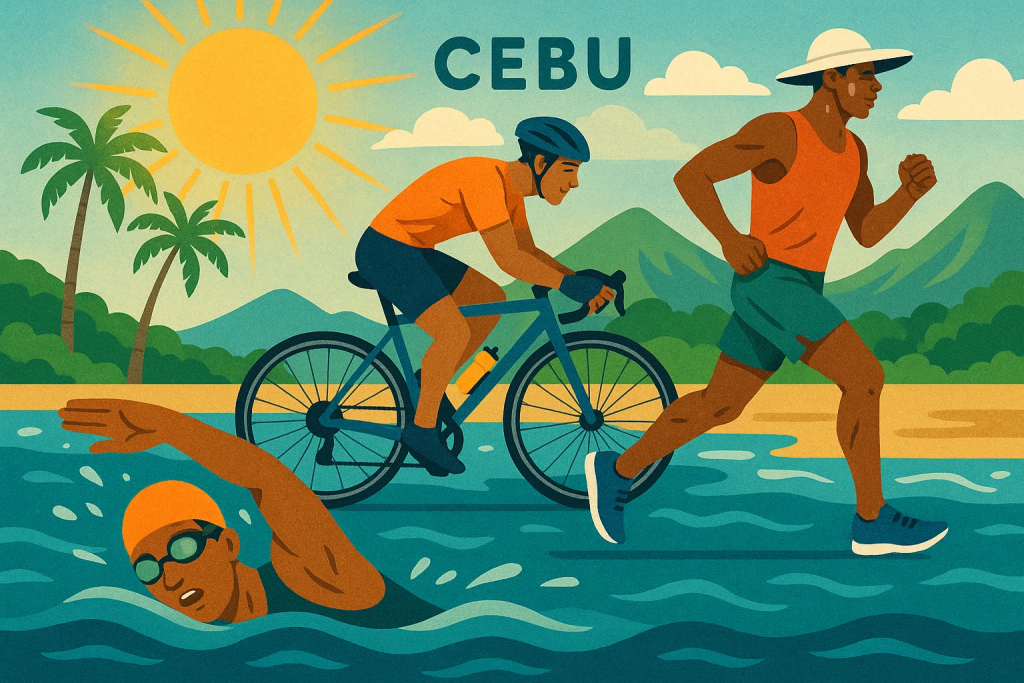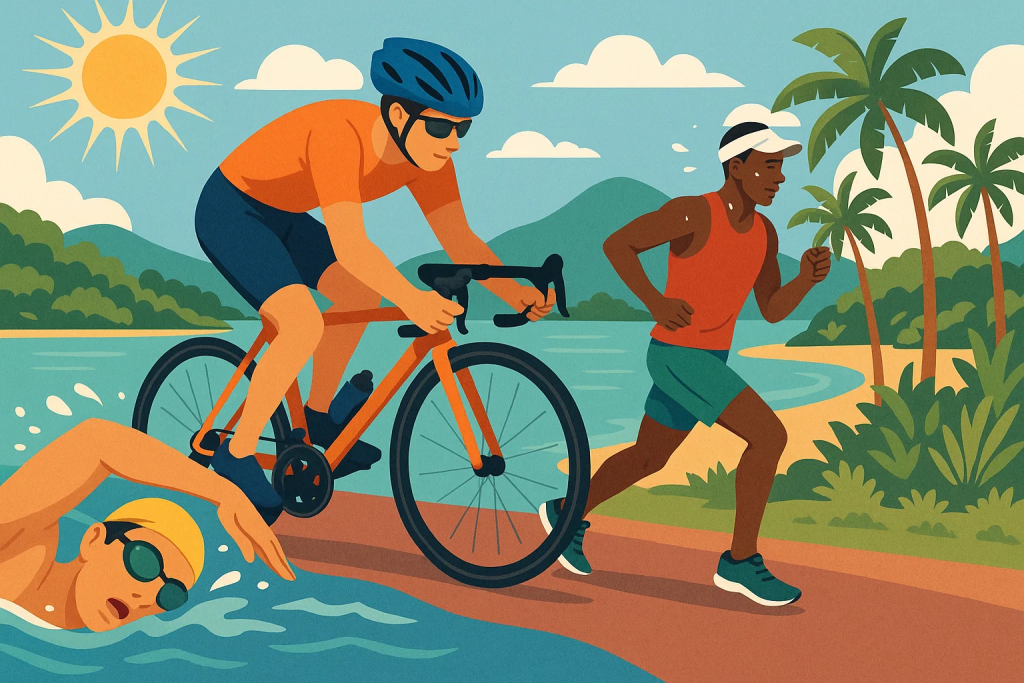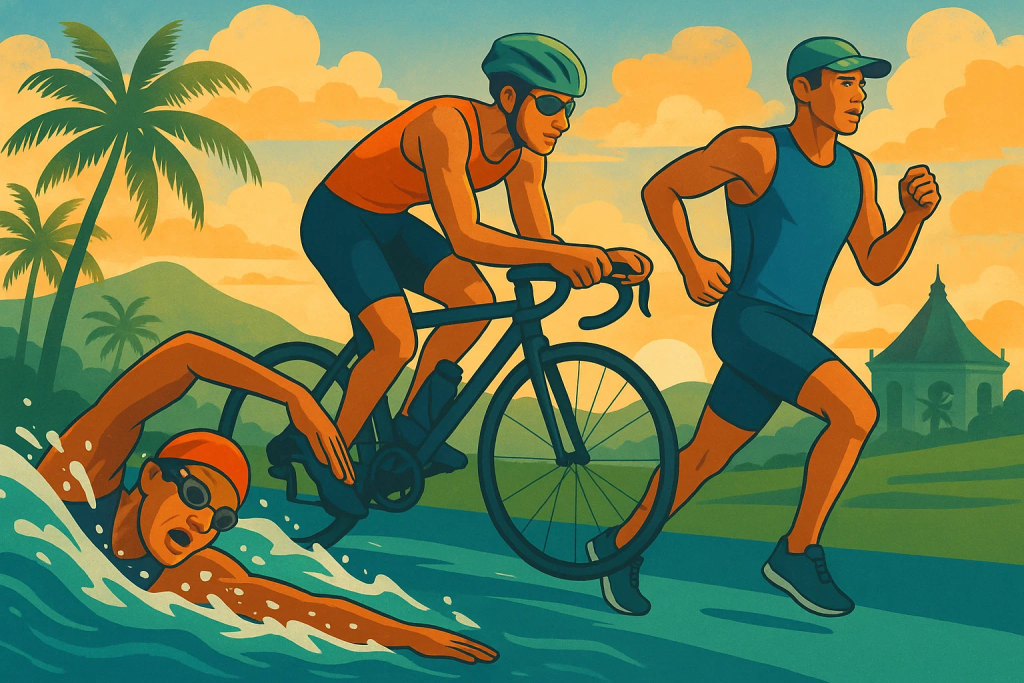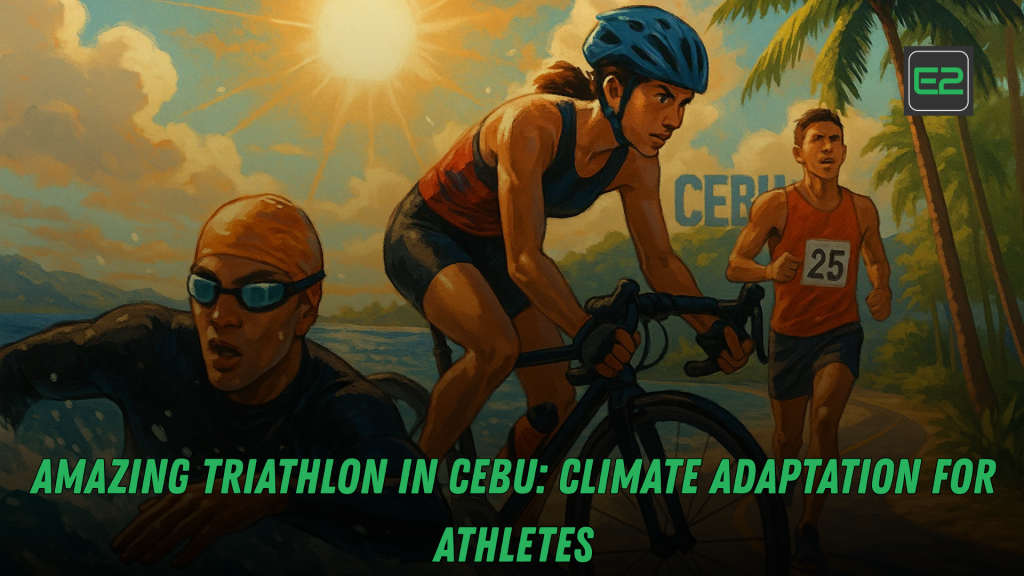Table of Contents
Why Cebu’s tropical climate is a performance puzzle (and opportunity)
Cebu is a dream race setting—coastal views, vibrant crowds, and a lively endurance scene. It’s also hot, humid, and sunny, with the kind of sticky air and radiant heat that punish poorly prepared athletes. Add gusty coastal winds and occasional squalls, and you’ve got a course that rewards smart adaptation more than brag-worthy fitness. The good news: heat is a trainable stress. With two weeks of focused acclimation, a sensible hydration and electrolyte plan, and temperature-aware pacing, you can flip climate from liability to advantage. This guide walks you through exactly how to do it.

1) Know the environment of Cebu: Heat, humidity, wind, and saltwater
- Heat + humidity reduce sweat evaporation. Your body runs hotter for the same power/pace. Expect cardiovascular drift (HR rises at a steady power) and higher RPE.
- Coastal wind can help with convective cooling on the bike but also demands aero stability and cautious handling during gusts or over bridges.
- Tropical sun means strong UV exposure; sun management (UPF kit, visor, sunscreen) is a performance tool, not just a comfort choice.
- Saltwater swim adds buoyancy but can irritate skin and eyes; practice tinted goggle sighting, rinse promptly after the swim, and use anti-chafe on neck/underarms.
- Rain bursts can make roads slick—especially the first minutes after a light rain—so brake smoothly, widen lines, and modulate corner speed.
Safety note: If you have any cardiovascular or medical concerns, consult a qualified clinician/sports physician before doing heat acclimation or racing in the tropics.
2) Heat acclimation that works in Cebu: A 10–14 day protocol
You don’t “tough it out”—you teach your body to manage heat. Key adaptations include earlier sweating, higher sweat rate, lower skin and core temperature at a given workload, and lower heart rate for the same pace.
The step-by-step plan (mix and match to your build)
Days 1–3 (intro):
- 40–60 min Z2 bike or run in warm conditions (or overdress indoors).
- Finish with 10–15 min “heat hold”: easy spin/jog right after the session with extra layers to keep body temp elevated.
- Hydrate normally; do not chase aggressive sweat losses yet.
Days 4–7 (progress):
- 60–75 min aerobic with last 15–20 min at race-like effort (Z3/tempo) in heat.
- Add one brick (30–40 min bike → 15–20 min run in heat).
- Begin post-session sodium replacement (see Section 3).
Days 8–12 (specifics):
- 75–90 min aerobic with two tempo blocks (2 × 10–15 min).
- One long session where you practice race hydration and fueling in heat.
- Keep one session in cooler conditions to protect quality and avoid cumulative fatigue.
Days 13–14 (taper into race):
- Reduce volume 30–40%, keep short “pop” efforts.
- Prioritize sleep, carbs, and hydration; maintain brief warm sessions to hold adaptations without fatigue.
Rules of thumb
- Feel “uncomfortably warm,” not ill. If you get chills, headache, confusion, or stop sweating, stop immediately and cool down.
- Don’t chase PR intervals during acclimation; the goal is adaptation, not hero splits.
3) Hydration and electrolytes: Do the sweat math
Why it matters: In humid heat, you sweat more but evaporate less, so cooling is inefficient. Losing too much fluid and sodium degrades power, cognitive function, and gut tolerance.
A quick sweat-rate test (do this 2–3 times)
- Weigh yourself naked pre-workout.
- Train 60 minutes at race intensity in similar heat; track all fluid intake.
- Towel off and weigh again.
- Sweat rate (L/h) ≈ (pre-wt – post-wt + fluids in – urine out) / 1 hour.
Repeat in different conditions; take an average.
Building your plan
- Fluid target: Often 0.5–1.0 L/h works for many; use your sweat-rate data and gut tolerance to set the exact number.
- Sodium: Start around 500–800 mg sodium per hour; heavy/salty sweaters may need >1,000 mg/h. Split across drink mix, gels, and salt caps.
- Pre-hydrate (2–3 hours out): Sip 6–8 ml/kg of fluid with 300–600 mg sodium to start topped up.
- On-course: Prefer cool or cold fluids when possible; they lower RPE and help gastric emptying.
- Hyponatremia caution: Don’t overdrink plain water. Pair fluids with sodium, especially if you’re >3 hours out there.
Pro tip: Label your bottles “Bike 1, Bike 2…” with ml + sodium numbers so you’re not guessing mid-race.
4) Race-day nutrition for the tropics (train the gut)
Heat diverts blood to skin for cooling, which can challenge digestion. Practice your race menu in the same heat you expect on course.
- Carbohydrates: Target 60–90 g/h from a glucose+fructose mix for long events; some tolerate up to 100–110 g/h after gut training. Build up gradually.
- Liquids vs solids: In humidity, lean on carb-rich fluids and soft gels/chews; keep solids small and simple to reduce GI load.
- Caffeine: Useful for alertness and RPE; total race intake 2–3 mg/kg in split doses works for many. Test tolerance well before race week.
- Run strategy: Alternate sports drink + water at aid stations; use ice in hat/jersey and sponges (if offered) to keep core temp down—this helps the gut too.
- After swim: Rinse salt quickly in T1, take a small rinse mouthful of water before swallowing fluids to reduce throat irritation from saltwater.

5) Pacing with the heat index (bike and run)
The biggest mistake in Cebu conditions is “racing your training.” Heat makes your training-zone math lie unless you adjust.
- Bike: If your target is, say, 70–75% of FTP for a 70.3, consider starting 3–5 percentage points lower for the first 20–30 minutes, then reassess by HR/RPE and core feel. Use headwind sections as cooling opportunities—stay aero, drink, and keep cadence fluid.
- Run: Cap early HR and drift into pace. Use shade lines, aid station cadence (walk 10–15 seconds to drink/ice), and spray cool but avoid soaking shoes before technical sections.
- Decision rule: If HR climbs while power/pace falls and RPE skyrockets, you’re overheating or under-hydrated. Back off, cool, and fuel—you’ll pass those who don’t.
6) Swim specifics: Salt, glare, and calm breathing
- Acclimate in saltwater at least twice pre-race; practice sighting into glare with tinted or polarized goggles.
- Start calm: Two minutes of box breathing (inhale 4, exhale 6) before the gun blunt the adrenaline spike.
- Draft smart: Sit on feet/hips of swimmers at your speed; it reduces energy cost and keeps breathing calmer in chop.
- Jellyfish/irritants: Light rash guard or well-fitted tri suit, petroleum-free anti-chafe on hot spots, and no touching face with salty hands.
- Exit plan: Visualize hand-to-knee to stand, walk tall to stabilize blood pressure, and breathe smoothly into T1.
7) Gear for tropical racing: What to bring and why
- Tri suit: Light-colored, UPF-rated fabric with good vent panels; snug but not constricting.
- Headwear: Visor for airflow or cap for ice retention; rotate sponges/ice under cap.
- Sunscreen: Reef-safe, broad-spectrum SPF 50, applied 30–45 min pre-start; reapply in T2 if exposure is long.
- Goggles: Tinted/polarized primary + clear backup.
- Bike: Reliable tires (consider slightly wider for grip on slick roads), latex tubes if you know how to manage heat, fresh brake pads, and a well-lubed chain.
- Hydration: Between-arms bottle + frame bottle minimum; plan for concentrate + water pickup or full premix depending on aid layout.
- Run kit: Lightweight socks, anti-blister lube, sunglasses with high UV and anti-fog.
- Cooling: Soft flask for ice slurry (if you tolerate it), small cooling towel in T2 bag.
8) Travel and timeline: Arrive ready, not fried
- Arrival: 4–7 days early is ideal; it lets you sleep, sweat, and scout.
- Jet lag: Anchor to local time on day one—morning sunlight, local meal times, and short movement sessions.
- Food & water: Stick to familiar, cooked foods race week; introduce new local dishes after the finish line.
- Bike care: Humid air + salt = corrosion risk. Wipe drivetrain, re-lube lightly, and store indoors.
- Course recon: Swim a short segment (with lifeguards), ride a safe portion of the bike route in daylight, and jog the first/last 1–2 km of the run to pin down aid station rhythm.
9) Environmental ethics on Cebu: Race beautiful, leave no trace
Cebu’s waters and reefs are treasures. Choose reef-safe sunscreen, secure gel wrappers, use aid-station bins, and be courteous in crowded transitions and local streets. Strong communities are part of what makes racing in Cebu special—respect the volunteers and neighbors who make race day possible.
10) The two-week “Cebu-ready” training template (customize as needed)
Mon (W1): 60 min Z2 run in heat + 10 min heat hold; mobility
Tue: 75–90 min bike (include 2 × 12 min tempo), practice hydration; 15–20 min brick jog
Wed: Easy swim + strength (30–40 min)
Thu: 60–75 min run with progressive last 20 min in heat; strides
Fri: Easy spin 45–60 min + drills; short open-water if available
Sat: Long bike (2–3 h) in warmest safe window; nutrition rehearsal
Sun: 70–90 min run, cooler conditions for quality + strides
Week 2 (taper, hold adaptations)
- Reduce volume 30–40%; keep one heat exposure run (30–40 min) and one short tempo bike (2 × 8–10 min).
- Focus on sleep, carbs, and calm pre-race routines.
11) Race-day execution checklist (print this)
Morning
- Eat 2–3 h pre-start; sip salted fluid.
- Apply sunscreen; set HR cap and bike power ceiling; review aid plan.
Swim → T1
- Calm start; rinse mouth quickly at T1; small sip of water.
Bike
- Start conservative 20–30 min; drink on schedule; ice/water over head if available; watch crosswinds.
- Check HR vs power each 30 min.
Run
- Aid station routine: water, sports drink, ice to hat/jersey, sponge; walk 10–15 seconds if needed to drink cleanly.
- Reassess at km 3, 7, and 15; finish strong.
Post
- Rehydrate with sodium; cool gradually; easy snack, then full meal.
12) Common mistakes (and quick fixes)
- Overcooking the bike: Fix by setting a “no-pass” early HR/power cap.
- Under-salting: Cramping, brain fog? Add 300–500 mg sodium over the next hour and reassess.
- New foods race week: Keep it boring; save adventurous meals for after.
- Skipping sunscreen: Leads to overheating and misery on the run.
- Ignoring signals: Dizziness, chills, nausea—stop, cool, and seek help.

Calvin Abueva’s Comeback Story: The Amazing Training Regimen Secrets Behind “The Beast”
Build your Cebu-ready plan now
If this guide helped clarify how to train, fuel, and pace for Cebu’s heat, do two things today:
- Save/print the hydration math, acclimation plan, and race-day checklist—tape them to your fridge or bike desk.
- Comment or message with your sweat rate, target distance (Olympic/70.3/long), and current weekly hours. I’ll help you tailor a 7-day microcycle and a personalized sodium plan you can test next weekend.
Final word: Cebu rewards athletes who respect the climate, rehearse their plan, and race with humility early and intent late. Adapt to the heat of Cebu on purpose—and enjoy the tropical finish line you trained for.
Frequently Asked Questions (FAQ)
1) How long before a hot race should I start heat acclimation?
You’ll see meaningful benefits in 7–10 days, with most adaptations landing by 10–14 days. Maintain with short warm sessions during taper. If you can’t train outdoors in heat, simulate it by overdressing or using a warmer room and finishing with a short “heat hold.”
2) How much should I drink per hour in Cebu’s humidity?
Use your sweat-rate test as the baseline. Many athletes land around 0.5–1.0 L/h, but gut tolerance rules. Pair fluids with 500–800 mg sodium/h (more if you’re a heavy/salty sweater). Avoid overdrinking plain water—sodium matters for performance and safety.
3) What carb intake works best in the heat?
Aim for 60–90 g carbs/h using a glucose+fructose combo from drinks, gels, and chews. Train your gut in the same heat you’ll race in. Some athletes can push 100+ g/h after progressive practice, but only if GI comfort stays solid.
4) Should I arrive early in Cebu?
Ideally 4–7 days before race day. That window lets you adjust sleep, get a couple of short heat sessions, and recon segments of the course. If travel is tight, prioritize sleep, simple foods, and light movement over big workouts.
5) What if it rains during the bike or run?
Expect slick patches, especially at the start of rain. Brake early, corner wide, and avoid painted lines and metal grates. On the run, accept a slightly slower pace but maintain aid-station routine. Rain can improve cooling—use it while keeping footing safe.
